Recent Posts
What to do if my basement floods?
7/8/2024 (Permalink)
 Within minutes of a water damage from standing water, everything becomes saturated. Furniture finishes may bleed onto carpet and paper goods swell up.
Within minutes of a water damage from standing water, everything becomes saturated. Furniture finishes may bleed onto carpet and paper goods swell up.
Basement flooding from thunderstorms in Cincinnati? Response time is critical when addressing standing water in the home to prevent further damage and costs.
Most homeowner’s insurance policies do NOT cover water damage caused by outside sources, like flooding from heavy rain.
This type of coverage may be offered as an endorsement, but it’s likely that any repairs necessary due to flooding from heavy rain into the home, will need to be paid for out of your pocket!
This is why quick action is essential in water restoration situations. Your local team of PROs is just a call away, with 24/7 emergency mitigation service.
Call 513 541 3200 NOW if you have standing water in your home.
Here are the DOs and DON’Ts of basement flooding (until help from SERVPRO® arrives):
- Remove and prop up wet upholstery, cushions, and colorful rugs
- Prop furniture legs up with wood blocks
- Use a mop to remove some of the excess water
- Do not leave wet fabrics, especially colored fabrics, in place: they will bleed and stain!
- Do not use electronic, plug-in appliances in the affected areas
- Do not use a household vacuum to try and suck up water
- Try to keep out of any rooms with sagging ceilings
Disaster Doesn't Care
7/1/2024 (Permalink)
 Quick action is essential in cleaning and restoration situations. That's why we offer emergency mitigation services!
Quick action is essential in cleaning and restoration situations. That's why we offer emergency mitigation services!
It can, and will, happen at any time.
Around 75% of businesses do not have a disaster plan in place, and about half of businesses close after experiencing a disaster.
Get ahead of the curve. Preparation is key to preventing excess costs and damages. Knowing what to do, where to go, and who to contact, is key to a timely restoration process and getting your business back on track.
SERVPRO of Northwest and Northeast Cincinnati keeps your business prepared with an Emergency Ready Profile. This complimentary service minimizes business interruption in the event of a disaster by providing an immediate plan of action.
WHY get an ERP with SERVPRO®?
- NO cost assessment of your facility.
- Concise Profile Document that contains ONLY critical information needed in the event of an emergency for YOUR needs.
- Includes a guide to help you get back into your building after a disaster, quickly.
- Establishes your local SERVPRO® Franchise as your disaster mitigation and restoration provider, giving you priority during disaster events.
- Identifies the line of command for authorizing work to begin, saving you time and money.
- Provides facility details such as shut-off valve locations, priority areas, and priority contact information as reference to you and your team during a disaster emergency.
Our team understands the panic and stress created by disaster situations due to water or fire. Let us take some of it away and help you be prepared. Call today to inquire about setting up an ERP: 513 541 3200
Mold and Mushroom Growth from Water Damage
6/17/2024 (Permalink)
 Did you know mushrooms can sprout during mold growth after a water damage?
Did you know mushrooms can sprout during mold growth after a water damage?
Pictured is what you would call a not-so-fungi...
Get it?
You're looking at water damages from a large pipe leak which resulted in rapid mold growth that even sprouted a few mushrooms.
In this case the mold growth is clearly visible due to a large leak but sometimes mushrooms can form without visible mold spores.
What should you do if you see a not-so-fungi hanging around your home uninvited?
It is likely a sign of high humidity levels or hidden water damage and mold spores.
- Locate and address the source or cause of the water damage or mold growth. Even if the water damage or mold growth is mitigated or removed, there is a chance these damages will return if the source or cause is not fixed first.
- Call a water damage and mold removal specialist (pssst...WE can help with this) to professionally clean and restore the damaged areas. Do not try to clean or remove the moldy areas yourself!
SERVPRO Team Roberts is Here to Help® with:
- Mold Inspection and Mold Damage Assessment
- Mold Containment and Mold Remediation
- Advanced Air Filtration Technology
- Mold Damage Repair and Construction Services
- Emergency Mitigation Service
* Local and state laws may require a specific inspection and documentation protocol based on the size of the affected area. We can advise you on this process, providing guidance based on your unique situation.
Did you know mold can occur within 24-48 hours of a water damage?
Response time is critical when addressing water damages and mold to prevent further costs and repairs. That's why we're Faster to Any Size Disaster™.
Learn more about our Mold Removal and Remediation Services.
Commercial restoration in Cincinnati
7/5/2023 (Permalink)
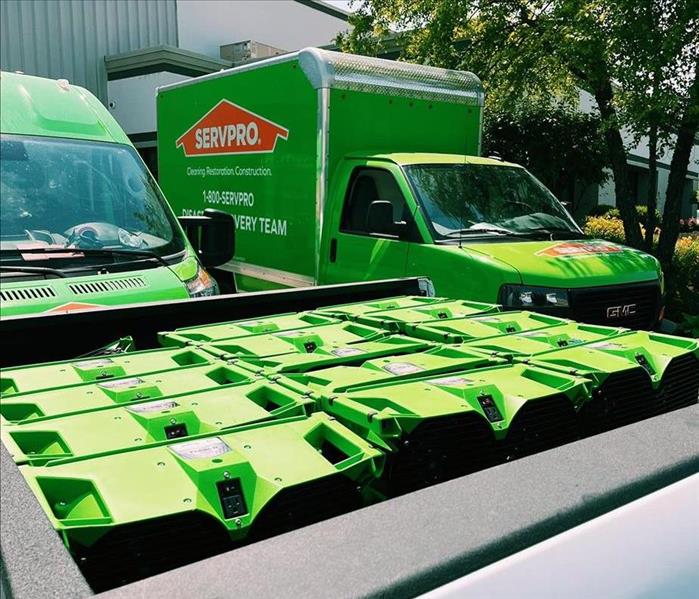 SERVPRO® is equipped with the tools and the team necessary to get the job done, the right way.
SERVPRO® is equipped with the tools and the team necessary to get the job done, the right way.
Has your business recently been affected by water, storm, or fire damage? You’re not sure who to contract through your business insurance to ensure the job is done quickly and professionally at such a large scale…well you found us! Your local SERVPRO® in Northwest and Northeast Cincinnati, North and South Clermont Counties, and Downtown Cincinnati is equipped with the tools and the team necessary to get such a job done, the right way.
No job is too small or too large. Trust the recognized #1 franchise in the restoration category in Entrepreneur’s 2022 Franchise 500® to effectively restore your property to preloss condition and get your business back on track. We work directly with insurance companies for a smooth claims process.
Our ownership team ensures each franchise has the help it needs, should there be a large-scale loss in the area. Our crews are always ready to help 24/7 with emergency restoration needs.
Rest assured that, should your business property ever need restoration services, SERVPRO® is your one stop shop from water mitigation, smoke damage removal, mold remediation, and reconstruction!
Is Cincinnati affected by the Canadian wildfires?
6/28/2023 (Permalink)
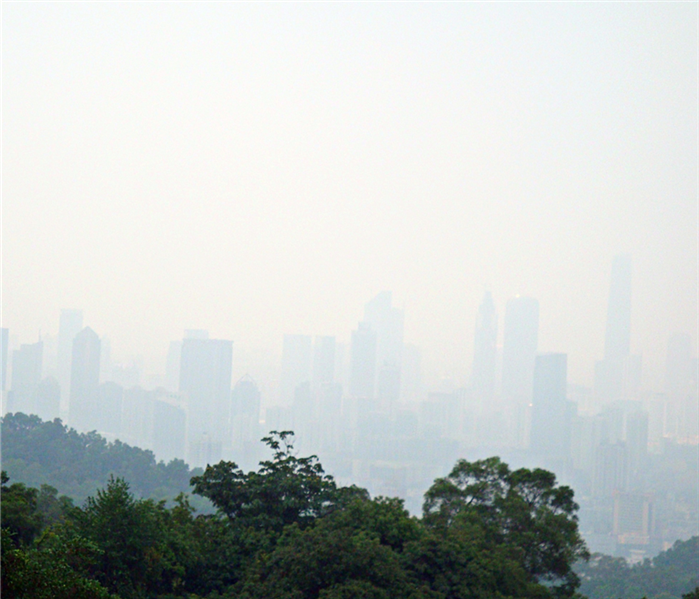 The air quality on Wednesday June 28th is reading "unhealthy for sensitive groups" in Cincinnati tristate area.
The air quality on Wednesday June 28th is reading "unhealthy for sensitive groups" in Cincinnati tristate area.
The sky is hazy this morning in the Greater Cincinnati and Northern Kentucky tristate areas. Smoke from wildfires in Canada is affecting the air quality in the Ohio Valley Region. These areas are reading in the orange and red zones on the Air Quality Index, which indicates that the air is unhealthy, especially for some groups like those with asthma or respiratory sensitivities.
The Southwest Ohio Air Quality Agency issued an air quality alert for Wednesday June 28th for the following counties within the tristate: Butler, Clermont, Hamilton, and Warren in Ohio; Campbell and Kenton counties in Kentucky; Dearborn County in Indiana. The Agency expects levels of ozone and PM2.5 detected on the range of the Air Quality Index.
It is advised that you limit or avoid the outdoors during an air quality alert, especially if you are part of a sensitive group such as those with asthma. To learn more, visit https://www.southwestohioair.org/187/Air-Quality-Alert.
Does homeowners insurance cover pools?
6/16/2023 (Permalink)
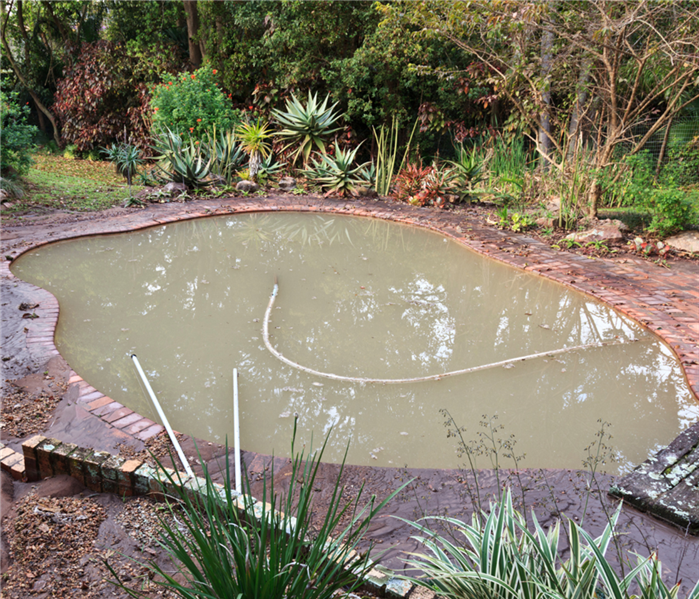 Homeowners insurance usually covers your pool within the same coverage of your home (weather-related damage, fire, etc.).
Homeowners insurance usually covers your pool within the same coverage of your home (weather-related damage, fire, etc.).
Short answer, yes. Homeowners insurance usually covers damage to your pool and pool cages attached to your home within the same risks your home is covered by (weather-related damage, fire, etc.). It also protects your liability should someone get hurt in your pool and decide to sue you for damages.
Having a pool usually increases your insurance premiums due to the added potential dangers.
Coverage eligibility and insurance requirements for your pool will vary by pool type, insurer, personal property, and other factors.
What if my pool floods?
With heavy enough rain there is a possibility that your swimming pool floods. This may be more concerning for those with inground pools close to the home. Depending on the severity of the flood, your home may be affected by water damage. This damage should be covered by your insurance policy. Be sure to document any damage due to the flooding for coverage purposes. Check the pool pump, pipes, and filter for cracks or damage.
Your insurance company should contact SERVPRO® to mitigate and restore any contents, flooring, walls, or drywall that may have been affected by flooding. A quick response to water damage will best ensure no further damage, like mold growth, occurs, which will mean more work to be done and more costs to you. SERVPRO® is always Here to Help®!
What to do if a tree falls on my house?
6/14/2023 (Permalink)
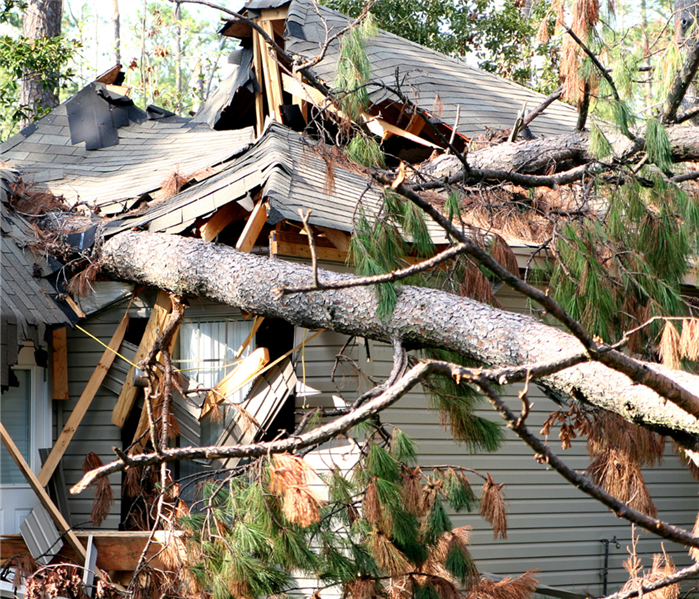 You never know when a tree will fall on your home, but you can make sure you’re prepared.
You never know when a tree will fall on your home, but you can make sure you’re prepared.
Living in and around Cincinnati, we are prone to windy weather and thunderstorms. Sometimes the wind can be so severe, or lightning may strike, and you may end up with a fallen tree on your property. Or a rotted tree finally topples. Here’s what to do if a tree falls on your home:
First, ensure everyone is safe, including your pets. Once everyone is accounted for, you can focus on minimizing additional damage and getting the damage repaired.
You should also call 911 and the electrical company since there’s always a chance the fallen tree took a power line down with it, which creates a hazardous situation with increased risk of fire or deathly electrical shock.
Make sure to document everything. Take photos and videos of the damaged areas in and around your home, in multiple angles and perspectives. You can never have too many photos or videos as evidence of what was damaged and what needs replaced or repaired.
Contact your insurance company. Your homeowner’s insurance will likely cover the damage and possibly the cost of debris removal. This will open a claim and an adjuster will be assigned to look at the property and account for what will be covered.
Next, either you or your insurance company will contact a contractor to remove the tree and restore your home to pre-tree condition. Call SERVPRO of Northwest and Northeast Cincinnati!
We are your one stop shop for restoration and reconstruction needs! SERVPRO will remove the tree, tarp up your roof, replace or repair ceiling and drywall damage, and more! We work directly with insurance companies for a smooth claims process.
You never know when a tree will fall on your home, but you can make sure you’re prepared. SERVPRO is ready for whatever happens and is here to help you 24/7.
What is a Sump Pump and How Does it Work?
5/24/2023 (Permalink)
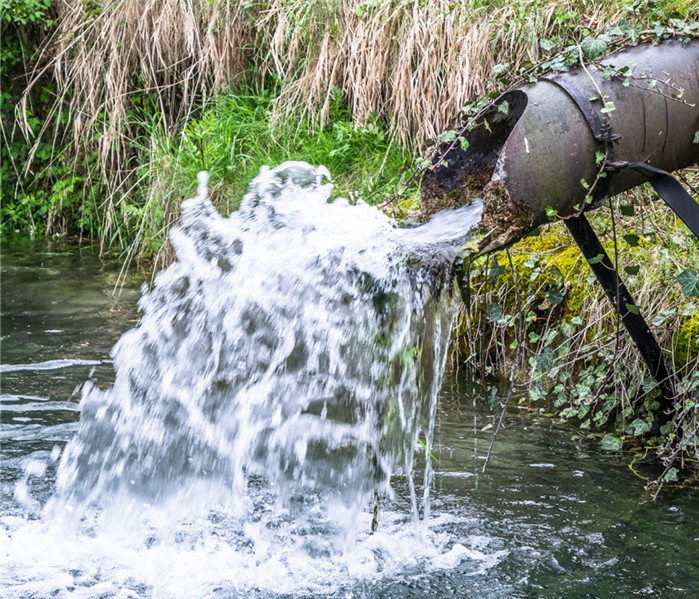 A sump pump automatically directs excess water to a designated discharge area, such as a creek, pond, lake, or neighborhood drain.
A sump pump automatically directs excess water to a designated discharge area, such as a creek, pond, lake, or neighborhood drain.
You may have heard from your neighbors, friends, family, or coworkers about how their sump pump saved their home during a thunderstorm, but not have a clue as to what they’re talking about! So…what is a sump pump?
A sump pump is a kind of pump typically located in a basement or crawl space that removes excess or accumulated water to a place where it can be safely drained away, outside. The water may enter from drain backups, rainwater, or flooding. The device is equipped with valves that sense rising water levels and automatically pump out any excess water to a designated discharge area, such as a creek, pond, lake, or neighborhood drain.
Do I Need a Sump Pump?
Having a sump pump can be somewhat of a lifesaver in times of heavy rain and storms in your area. Living in and around Cincinnati, this may be a good idea due to the heavy rain and snow we get throughout the year. This can be especially helpful if your property is on a flood-prone plot, you’ve experienced water problems in the past, or if your basement is finished.
Here are some of the advantages of installing one in your property:
- Prevent and defend your home from flooding
- Reduce mold, mildew, and fungus growth
- Improve indoor air quality
- Keep the basement or crawl space drier
- Meet a requirement for homeowners insurance coverage of basement flooding
Sump Pump Failure
Sump pumps are not a perfect preventative or protective solution to your home or business. Sump pumps do have a chance of malfunctioning, or failing, should discharge lines become clogged or frozen. The most common mechanical failure is a stuck or faulty switch, or the motor may become burnt out.
If a sump pump fails in your home causing a water backup, your homeowner’s insurance will more likely cover any damage costs due to the water damage.
As always, should your Cincinnati home or business need water damage restoration, you know who to call: SERVPRO of Northwest and Northeast Cincinnati, the disaster recovery PROs. We work directly with property owners and insurance companies for a smooth claims process. Our crews are ready 24/7 for emergency restoration services.
Sunny With a Chance of...Thunder?
5/10/2023 (Permalink)
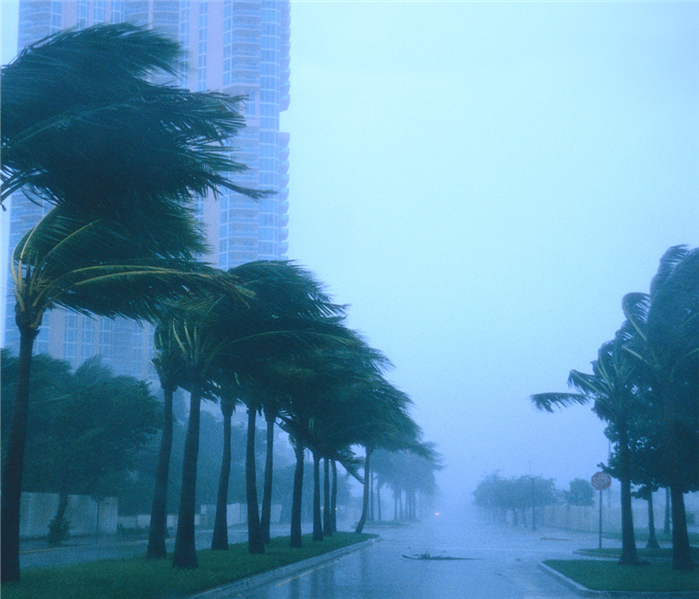 The National Lightning Safety Institute says, “If you can see it, flee it; If you can hear it, clear it.”
The National Lightning Safety Institute says, “If you can see it, flee it; If you can hear it, clear it.”
We’re all growing excited as summer fun grows closer. The kids are getting out of school, maybe you’ve got a trip coming up, and you’re already planning the family cookouts and upcoming holidays-- life is pretty good.
The season is filled with sunshine and good times, and what most of us keep on the back burner or don’t think even about when we imagine summer is the threat of severe weather and thunderstorms.
Extreme weather can strike at any time, and it’s important to be prepared in such instances, even when times seem sunny-side-up. Here are some tips, reminders, and refreshers for Summer Storm Safety:
Being Prepared is Being Smart, and Being Smart is Being Safe
Swimming
- If a storm hits while you’re swimming in a pool or ocean, lying on the beach, or playing at a water park, remember the 30/30 rule: Go inside or seek shelter if you cannot count to 30 between seeing a lightning strike and hearing a thunderclap, and don’t go back out until 30 minutes have passed since the last thunderclap.
- You may be able to swim in an inside pool during a thunderstorm if it does not connect to an outside pool.
- Pool owners: don’t drain or cover your pool. Covers can become flying hazards. Keeping the pool full keeps it heavy and less apt to move. Clear away toys, umbrellas, furniture, and other items that can be damaged or cause damage in the event of a storm.
Camping
- Have alternatives for shelter. A tent will keep you dry from rainfall but serves no protection against lightning. If you can, get in your vehicle or campsite resident building. Your tent should be a last resort.
- Know the terrain. Thunderstorms in mountainous areas are the most dangerous due to higher elevations. Desert terrains with box and slot canyons can also be very dangerous.
- Choose your campground wisely. If you’re looking to make camp with protection from potential severe weather in mind, try to avoid these spaces: open areas where you may be vulnerable to a direct strike, near isolated trees where you may be vulnerable to side flashes, bodies of water, high or exposed terrain.
- Invest in a National Oceanic and Atmospheric Administration (NOAA) radio. This is especially helpful should the weather turn in your sleep, as the device sound an alarm if there is severe weather nearby.
The National Lightning Safety Institute says, “If you can see it, flee it; If you can hear it, clear it.”
Preparedness
- In any season, it’s important to have a storm prep plan in place. Even on vacation! A checklist of items to keep on hand or in your vehicle include bottled water, flashlights, first aid kit, nonperishables, whistle (or item that can be a signal for help).
- Before going away, depending on the duration of your stay, it can be a good idea to check on your home’s insurance policy in case of storm or non-storm related property damage and update where necessary.
- Prior to leaving your hotel or room, be sure to check your location’s weather daily and plan your activities accordingly! It’s better to be safe than sorry.
After a Storm
- Even after a storm has settled, it’s important to be aware of the dangers that still linger: Stay away from downed power lines; Never drive through a flooded roadway; Keep clear of areas badly affected as there is risk of falling debris.
- Only leave your house/resort/hotel once it’s officially OK to do so!
Stay Safe, Stay Smart, and Have Fun This Summer!
Your Local Disaster Recovery PROs
4/11/2023 (Permalink)
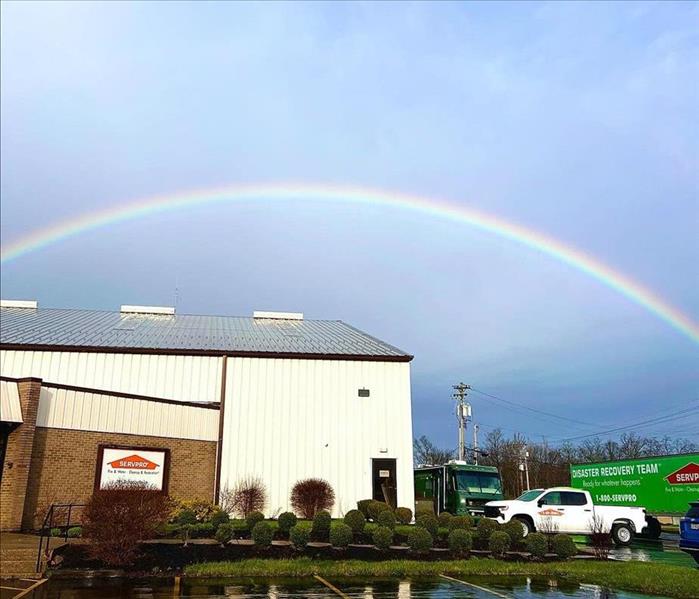 Your local SERVPRO is Here to Help.
Your local SERVPRO is Here to Help.
SERVPRO initially started as a small, family-owned painting company more than 50 years ago and has grown into the #1 choice in the cleaning and restoration industry with over 2,000 franchise locations across North America.
Faster to Any Size Disaster
With so many independent locations, you can rest assured that there is a SERVPRO just a phone call away for emergency disaster recovery needs, should you ever need it. All franchises are locally owned and operated, with people who actively live in your neighborhood.
Award-Winning Leaders
SERVPRO receives regular recognition for excellence in a variety of fields, including the 2021 Entrepreneur Award, recognized as the #1 franchise in the category and #1 in the Restoration Services Category since 2003.
Residential and Commercial Services
We proudly serve home and business owners with quality expertise in the restoration industry by working efficiently with insurance companies and individuals for a speedy recovery process. There is no job too small or big – SERVPRO is Here to Help!
Provided Services
Professional cleaning, crime scene clean-up, vehicle deodorization, mold remediation, water mitigation, contents cleaning, roof tarp-ups, fire restoration, you name it! SERVPRO specializes in many areas of restoration and cleaning. Your local franchise is ready 24/7 for emergencies.
Got a situation you’re not sure about? Just give us a call at 513-541-3200. SERVPRO is ready for whatever happens.
 Within minutes of a water damage from standing water, everything becomes saturated. Furniture finishes may bleed onto carpet and paper goods swell up.
Within minutes of a water damage from standing water, everything becomes saturated. Furniture finishes may bleed onto carpet and paper goods swell up.

 24/7 Emergency Service
24/7 Emergency Service








